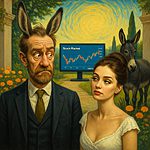Overconfidence Bias: Leads to Dangerous and Costly Mistakes in Investing
April 26, 2025
Overconfidence bias, a cognitive phenomenon where individuals overestimate their abilities, knowledge, or chances of success, can lead to disastrous consequences in investing. This pervasive psychological trap affects both novice and experienced investors, often leading to poor decision-making and significant financial losses. According to a study published in the Journal of Behavioural Finance in 2023, nearly 74% of individual investors exhibit some degree of overconfidence in their investment decisions.
We will examine how overconfidence bias manifests in financial decision-making, its psychological underpinnings, and the costly mistakes it can lead to. We’ll discuss recent research findings, including a 2022 study from the National Bureau of Economic Research that found overconfident investors trade 25% more frequently than their peers, leading to annual returns that are, on average, 4% lower.
By incorporating elements of crowd psychology, technical analysis, and cognitive bias, we’ll delve into the multifaceted nature of this phenomenon and its impact on investment outcomes. We’ll analyse real-world examples, such as the 2021 meme stock frenzy, where overconfidence led many retail investors to significant losses. Additionally, we’ll explore how overconfidence interacts with other biases, like the Dunning-Kruger effect, to create a perfect storm of irrational investment behaviour.
The Ancient Roots of Overconfidence
The concept of overconfidence is not a new one. It has been recognised and warned against for millennia, with ancient wisdom offering profound insights into this cognitive trap. The ancient Greek philosopher Socrates (470-399 BC) famously stated, “The only true wisdom is in knowing you know nothing.” This insight serves as an early caution against overestimating one’s knowledge or abilities, underscoring the importance of intellectual humility.
Similarly, in ancient China, Lao Tzu (6th century BC), the founder of Taoism, observed, “He who knows does not speak. He who speaks does not know.” This wisdom highlights the often inverse relationship between true knowledge and the confidence with which one expresses opinions – an essential aspect of overconfidence bias.
Interestingly, these ancient insights resonate in modern psychological research. A 2022 study published in the Journal of Experimental Psychology found that individuals who scored higher on measures of intellectual humility (a philosophy akin to Socrates’) were less likely to exhibit overconfidence bias in decision-making tasks.
The ancient Roman philosopher Cicero (106-43 BC) also addressed this topic, stating, “The greatest wisdom is to know oneself.” This self-awareness, he argued, was crucial in avoiding the pitfalls of overestimation. Modern neuroscience has corroborated this view, with a 2023 study in Nature Neuroscience revealing that individuals with greater activity in brain regions associated with self-reflection showed less overconfidence in their decision-making.
These timeless insights from ancient thinkers, now backed by contemporary research, underscore the enduring nature of overconfidence bias and the ongoing struggle humans face in accurately assessing their abilities and knowledge. As we delve deeper into the psychological underpinnings of overconfidence in investing, these ancient warnings remind us that overcoming this bias is as old as human civilisation.
The Psychology of Overconfidence
Overconfidence is a bias deeply rooted in human psychology. Daniel Kahneman, a Nobel laureate and pioneer in behavioural economics, has extensively studied this phenomenon. In his 2011 book Thinking, Fast and Slow, Kahneman explains that overconfidence results from our brain’s tendency to create coherent narratives from limited information, often leading to unwarranted certainty.
This bias manifests in several ways in the investment world:
1. Illusion of Control: Investors often believe they have more control over outcomes than they do.
2. Overestimation of Knowledge: Many investors overestimate their understanding of financial markets and specific investments.
3. Miscalibration of Probabilities: Investors underestimate risks and overestimate potential returns.
4. Better-Than-Average Effect: Most investors believe their skills are above average, but this is not statistically true for everyone.
Mass Psychology and Overconfidence
The impact of overconfidence is amplified when viewed through the lens of mass psychology. Gustave Le Bon, a pioneering sociologist, wrote in his 1895 work “The Crowd: A Study of the Popular Mind” that “The masses have never thirsted after truth. They turn aside from evidence not to their taste, preferring to deify error if error seduces them.”
This insight helps explain how overconfidence can spread through markets, creating bubbles and subsequent crashes. When many investors are simultaneously overconfident about a particular asset or strategy, it can lead to irrational exuberance and inflated valuations.
A prime example of this occurred during the dot-com bubble of the late 1990s. Investors, overconfident in their ability to pick winning tech stocks and blinded by the promise of the internet revolution, drove valuations to unsustainable levels. When reality failed to meet inflated expectations, the bubble burst, leading to massive losses.
Technical Analysis and Overconfidence
Technical analysis, the study of market action through price charts and other indicators, can mitigate and exacerbate overconfidence bias. On the one hand, it provides a systematic approach to market analysis, potentially reducing the impact of emotional decision-making. On the other hand, it can lead to overconfidence if investors believe they can predict future price movements with certainty based on past patterns.
In his book “Technical Analysis of the Financial Markets” (1999), John J. Murphy, a renowned technical analyst, warns that ” the biggest obstacle to making money in the markets is not the market itself or any particular trading method. It’s the individual trader and his or her psychological makeup.”
This highlights the importance of combining technical analysis with a healthy dose of scepticism and an understanding of one’s own psychological biases.
Costly Mistakes Stemming from Overconfidence
Overconfidence can lead to a range of costly mistakes in investing:
1. Excessive Trading: Overconfident investors tend to trade more frequently, incurring higher transaction costs and potentially realising losses more often.
2. Inadequate Diversification: Overconfident investors may concentrate their portfolios in a few stocks or sectors, believing they can pick winners, increasing risk.
3. Ignoring Contradictory Information: Overconfidence can lead to confirmation bias, where investors tend to seek information that supports their views while overlooking contrary evidence.
4. Taking on Excessive Risk: Overestimating their ability to handle market volatility, investors may take on more risk than is appropriate for their financial situation.
5. Failure to Plan for Worst-Case Scenarios: Overconfident investors may not adequately prepare for potential market downturns or personal financial setbacks.
Historical Examples of Overconfidence in Investing
1. The South Sea Bubble (1720): Overconfident in the potential profits from South American trade, investors in the South Sea Company drove the stock price to unsustainable levels before it crashed spectacularly.
2. The Great Crash of 1929: Overconfidence in the “new era” of perpetual prosperity led to rampant speculation, ultimately culminating in the stock market crash that marked the onset of the Great Depression.
3. Long-Term Capital Management (1998): This hedge fund, led by Nobel laureates and Wall Street veterans, was so confident in its complex mathematical models that it took on enormous leverage. When the models failed, it nearly brought the global financial system to the brink of collapse.
4. The Global Financial Crisis (2008): Overconfidence in the stability of the housing market and the safety of complex financial instruments led to a near-collapse of the global economic system.
Overcoming Overconfidence Bias
Recognizing and mitigating overconfidence bias is crucial for successful investing. Here are some strategies:
1. Embrace Humility. As the legendary Benjamin Graham advised, “The investor’s chief problem—and even his worst enemy—is likely to be himself.”
2. Seek Diverse Perspectives: Seek viewpoints that challenge your own to avoid confirmation bias.
3. Keep a Trading Journal: Document your investment decisions and their outcomes for a realistic view of your performance.
4. Use Probabilistic Thinking: Instead of making absolute predictions, consider probabilities and ranges of outcomes.
5. Implement Systematic Strategies: Utilise rules-based approaches to mitigate the influence of emotional decision-making.
6. Continuously Educate Yourself: As Warren Buffett’s partner Charlie Munger says, “In my whole life, I have known no wise people who didn’t read all the time — none, zero.”
The Value of Embracing Uncertainty
Paradoxically, acknowledging uncertainty can lead to better investment outcomes. As the economist John Maynard Keynes famously stated, “It is better to be roughly right than precisely wrong.” This wisdom encourages investors to adopt a more nuanced and probabilistic approach to decision-making.
Modern thinkers, such as Nassim Nicholas Taleb, have expanded on this idea. In his 2007 book “The Black Swan,” Taleb argues that many of the most significant historical events were unpredictable and that we should focus on building resilience to uncertainty rather than trying to predict the unforeseen.
Conclusion: The Path to Wiser Investing
Overconfidence bias remains a persistent challenge for investors, leading to dangerous and costly mistakes. By understanding its psychological roots, recognising its manifestations in market behaviour, and implementing strategies to mitigate its effects, investors can make more rational decisions and achieve better long-term outcomes.
As we navigate the complex world of financial markets, let us heed Socrates’s words and cultivate a healthy scepticism about our knowledge and abilities. In doing so, we may avoid the pitfalls of overconfidence and open ourselves to new opportunities and insights.
Ultimately, successful investing is not about being right all the time, but about making thoughtful decisions based on a realistic assessment of our knowledge, the available information, and the market’s inherent uncertainties. By embracing this approach, we can transform the challenge of overconfidence into an opportunity for growth, learning, and ultimately, improved investment results.















